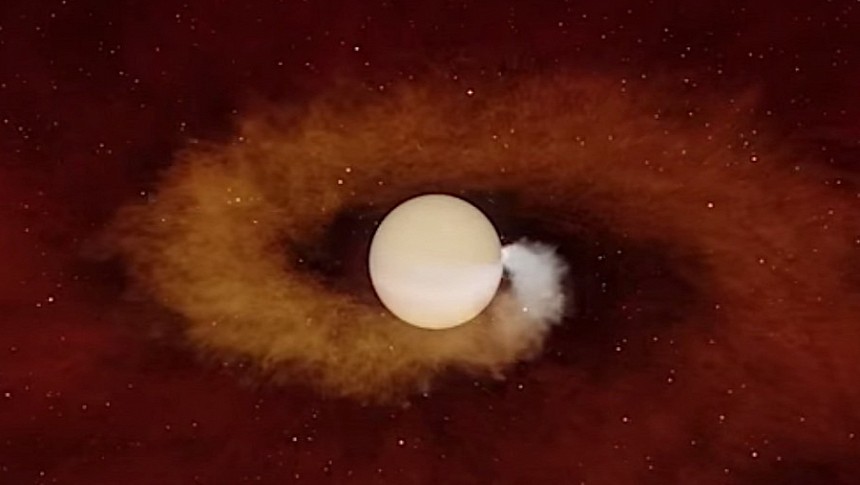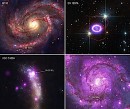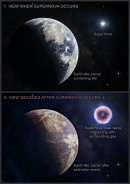Provided we don't blow ourselves up, or an asteroid puts an end to our civilization, we can consider ourselves safe from extinction for a very long time. But in about five billion years' time the Sun will not only end life on Earth, but devour the entire planet and several others with it.
Our Sun is not massive enough to turn supernova. It will however burn itself out and transform into a red giant. These are very large stars, devoid of hydrogen for nuclear fusion, that can have a diameter of anywhere between 62 and 620 million miles (100 million to almost one billion kilometers).
Just to give you an idea of what that means, consider that our Sun presently has a diameter of about 870,000 miles (1.4 million km). The planet in our solar system closest to it, Mercury, is at 36 million miles (58 million km), while Earth itself is located at a distance of about 93 million miles (150 million km) from it.
No matter how you look at it, once our Sun turns red giant and grows to as much as 100 times its current dimensions, it will eat up everything around it, up to and including planet Earth, and will slowly degrade the atmospheres of gas giants Jupiter and Saturn.
It's an event so cataclysmic that, if we don't leave this planet by then, means the end of everything.
Up until now we knew of such things happening elsewhere in our galaxy. We didn't get a chance to get a close-up look at such an event though until data gathered by the NASA Near-Earth Object Wide Field Infrared Survey Explorer (NEOWISE) spacecraft was analyzed by a team from the Massachusetts Institute of Technology (MIT).
The results of the study, which also took into account findings by the Zwicky Transient Facility (ZTF) camera, were published this week in the Nature journal, and speak of an event taking place in an unspecified part of the sky. Up there the star of a solar system turned red giant and began expanding far beyond its usual borders.
Orbiting the star at a distance possibly closer than Mercury is to our own Sun was a planet about the size of Jupiter. As its sun expanded, the planet was surrounded by the star's atmosphere. The drag caused by this slowed the planet's orbital speed, causing it to dive into the star itself.
In doing so, the "transfer of energy caused the star to temporarily increase in size and become a few hundred times brighter." It was this brightening that was spotted by human hardware.
You can have a look at how it all went down in the animation video below. Be warned, though, although rather simple in nature, it may appear graphic to some people, especially since this is something that will happen to us too.
As for the study into the discovery, this is the "first observation of an aging star swallowing a planet," and it will likely be followed by more in the years ahead.
Just to give you an idea of what that means, consider that our Sun presently has a diameter of about 870,000 miles (1.4 million km). The planet in our solar system closest to it, Mercury, is at 36 million miles (58 million km), while Earth itself is located at a distance of about 93 million miles (150 million km) from it.
No matter how you look at it, once our Sun turns red giant and grows to as much as 100 times its current dimensions, it will eat up everything around it, up to and including planet Earth, and will slowly degrade the atmospheres of gas giants Jupiter and Saturn.
It's an event so cataclysmic that, if we don't leave this planet by then, means the end of everything.
Up until now we knew of such things happening elsewhere in our galaxy. We didn't get a chance to get a close-up look at such an event though until data gathered by the NASA Near-Earth Object Wide Field Infrared Survey Explorer (NEOWISE) spacecraft was analyzed by a team from the Massachusetts Institute of Technology (MIT).
The results of the study, which also took into account findings by the Zwicky Transient Facility (ZTF) camera, were published this week in the Nature journal, and speak of an event taking place in an unspecified part of the sky. Up there the star of a solar system turned red giant and began expanding far beyond its usual borders.
Orbiting the star at a distance possibly closer than Mercury is to our own Sun was a planet about the size of Jupiter. As its sun expanded, the planet was surrounded by the star's atmosphere. The drag caused by this slowed the planet's orbital speed, causing it to dive into the star itself.
In doing so, the "transfer of energy caused the star to temporarily increase in size and become a few hundred times brighter." It was this brightening that was spotted by human hardware.
You can have a look at how it all went down in the animation video below. Be warned, though, although rather simple in nature, it may appear graphic to some people, especially since this is something that will happen to us too.
As for the study into the discovery, this is the "first observation of an aging star swallowing a planet," and it will likely be followed by more in the years ahead.








